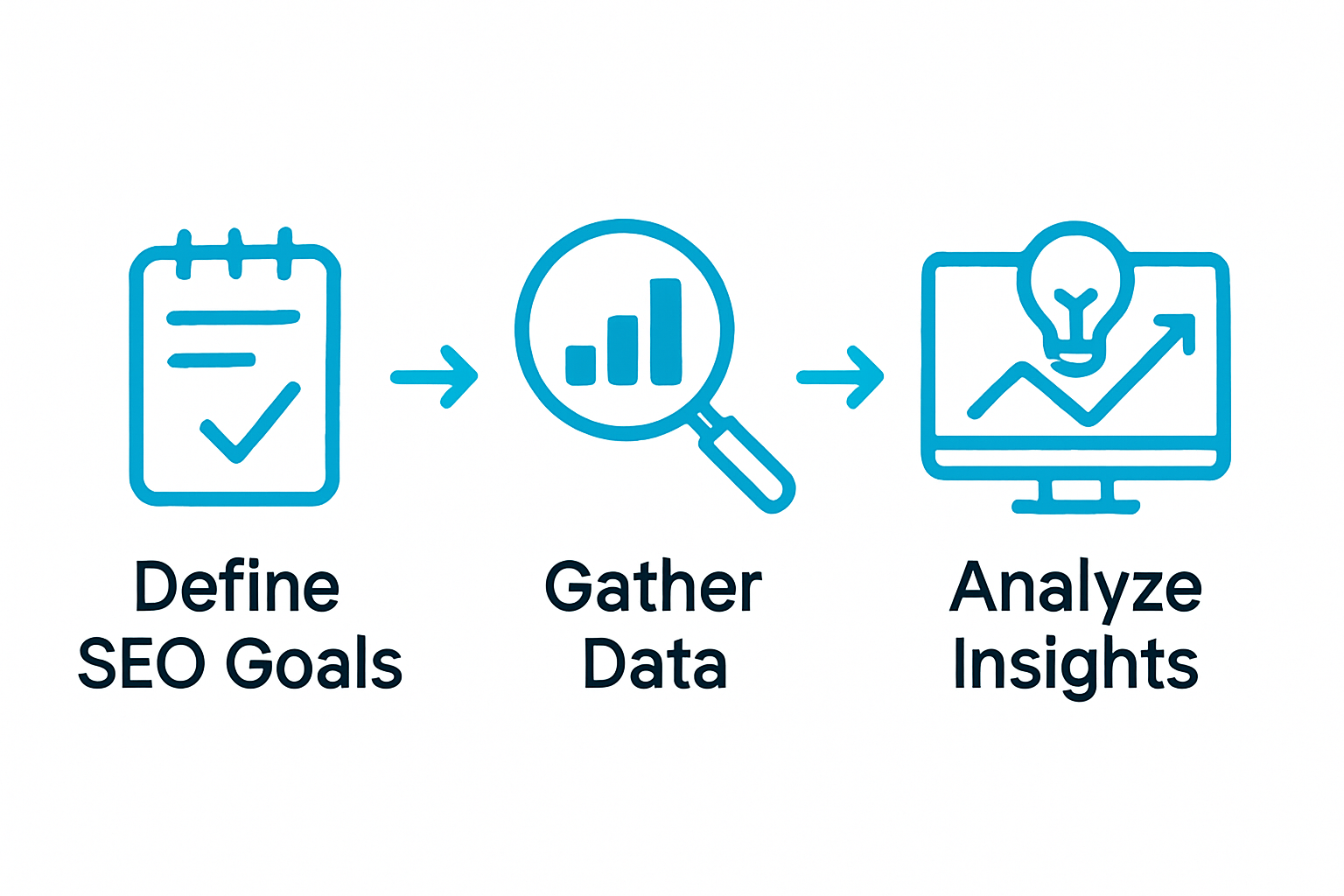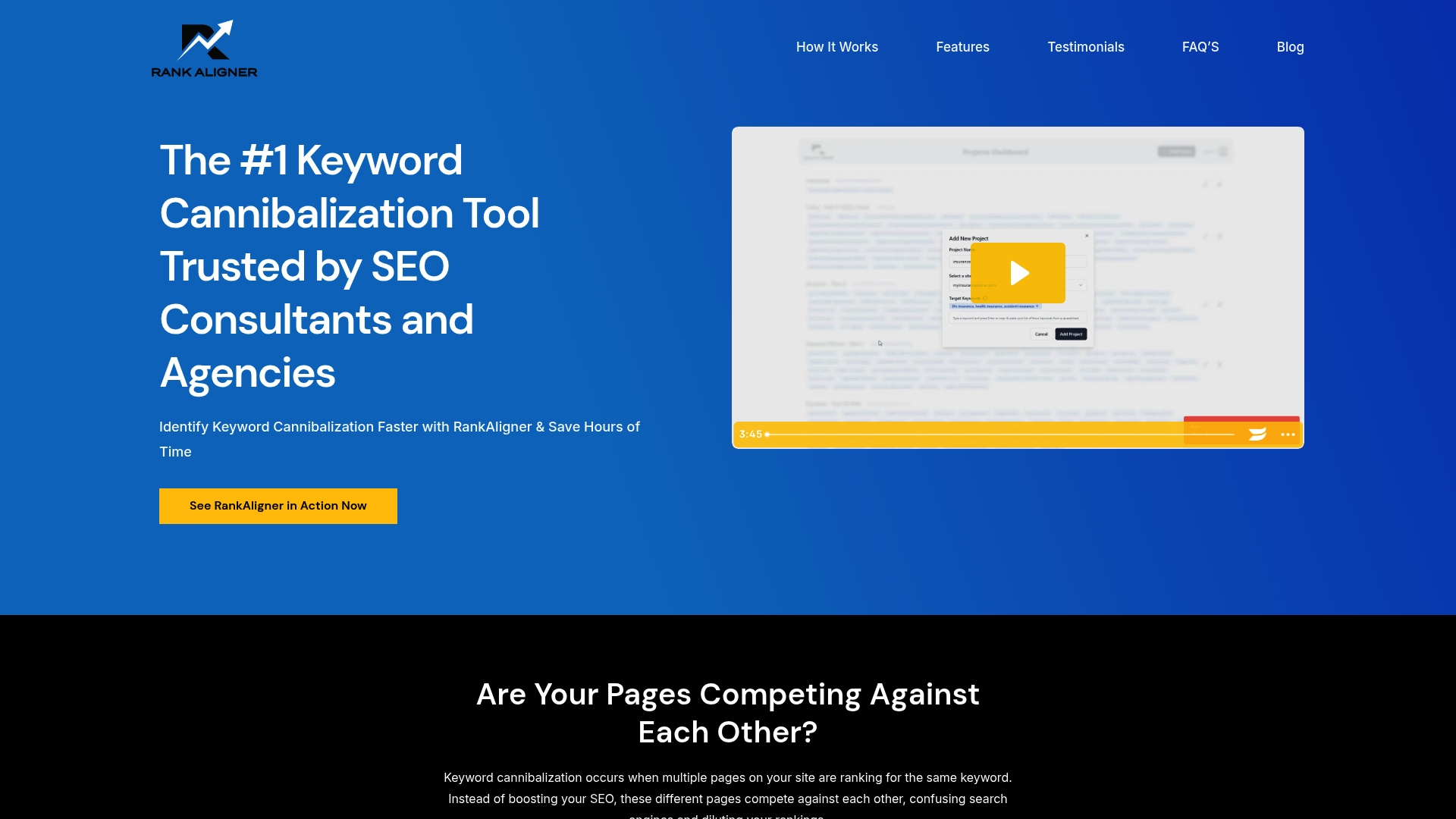SEO reports can look like a confusing jumble of numbers. You might expect that more data means clearer answers for your business. But almost 50 percent of marketers say their reporting is ignored because it’s too generic or disconnected from real goals. The right report does much more than summarize—it can become the roadmap your entire team wishes they had.
Table of Contents
- Step 1: Define Your SEO Reporting Goals
- Step 2: Gather Relevant Data Sources
- Step 3: Utilize SEO Tools for Data Collection
- Step 4: Analyze Data and Draw Insights
- Step 5: Format Your SEO Report Professionally
- Step 6: Review and Finalize the Report
Quick Summary
| Key Point | Explanation |
|---|---|
| 1. Clearly Define SEO Goals | Establish specific, measurable goals that connect SEO metrics to business outcomes for strategic reporting. |
| 2. Systematic Data Collection | Gather data from diverse platforms to develop a comprehensive performance narrative that informs decisions. |
| 3. Utilize SEO Tools Effectively | Choose the right tools for robust data analysis and easy integration of multiple metrics into your reporting. |
| 4. Analyze Data for Insights | Deeply analyze key metrics to uncover trends and insights that inform future SEO strategies and adjustments. |
| 5. Professional Report Formatting | Format your report to prioritize clarity and visual appeal, ensuring stakeholders easily understand the insights presented. |
Step 1: Define Your SEO Reporting Goals
Creating effective SEO reports begins with crystal clear goal setting. This foundational step transforms your reporting from a generic data dump into a strategic roadmap for marketing success. When you establish precise objectives, you provide your team with a targeted framework that connects raw SEO metrics directly to meaningful business outcomes.
Starting your SEO reporting process requires understanding what specific performance indicators matter most to your organization. Some businesses prioritize organic traffic growth, while others focus on conversion rates or keyword ranking improvements. Your goals should align with broader marketing and business objectives, creating a comprehensive narrative that demonstrates SEO’s tangible value.

Consider developing goals that are specific, measurable, achievable, relevant, and time-bound (SMART). For instance, instead of a vague objective like “increase website traffic,” craft a precise target such as “Increase organic search traffic by 25% within the next quarter by optimizing top 10 performing content pages and targeting three new high-value keyword clusters.” This approach provides clear direction and allows for precise performance tracking.
To effectively define your SEO reporting goals, conduct a comprehensive internal assessment. Engage with key stakeholders across marketing, sales, and leadership teams to understand their expectations and desired outcomes. Read our guide on SEO reporting best practices to gain deeper insights into creating goal-oriented reports that resonate across departments.
Key considerations when establishing SEO reporting goals include:
- Alignment with overall business strategy
- Measurability and data availability
- Potential for actionable insights
- Realistic and challenging performance targets
Remember that goal setting is an iterative process. Your initial objectives might evolve as you gain more data and understand your website’s performance nuances. Regularly review and refine your goals to ensure they remain relevant and impactful, maintaining a dynamic and responsive SEO reporting strategy.
Step 2: Gather Relevant Data Sources
Gathering comprehensive data sources is the critical backbone of creating powerful SEO reports. This step transforms raw information into strategic insights that drive marketing decisions. Your data collection process must be systematic, covering multiple platforms and analytics tools to provide a holistic view of your website’s performance.
Begin by establishing core data collection platforms that will serve as your primary reporting foundations. Google Analytics remains an indispensable tool for tracking website traffic, user behavior, and conversion metrics. Complement this with Google Search Console, which provides detailed insights into search performance, indexing status, and potential technical issues that might impact your SEO efforts.
Expand your data collection strategy beyond standard web analytics. Learn more about comprehensive ranking tracking to understand how different tools can provide nuanced performance insights. Professional SEO platforms like SEMrush, Ahrefs, and Moz offer advanced keyword tracking, backlink analysis, and competitive intelligence that can significantly enhance your reporting depth.
When collecting data, focus on gathering information from multiple sources to create a comprehensive performance narrative. Your data sources should ideally include:
- Website analytics platforms
- Search engine webmaster tools
- Keyword ranking trackers
- Social media insights
- Backlink analysis tools
Establish a consistent data collection schedule to ensure your reports remain current and relevant. Consider automating data retrieval where possible to reduce manual work and minimize human error. Most professional SEO tools offer scheduling and export features that can streamline your reporting workflow.
Pay special attention to data consistency and compatibility when pulling information from multiple platforms. Standardize your date ranges, ensure comparable metrics, and develop a systematic approach to data integration. This preparatory work prevents reporting inconsistencies and provides a more accurate representation of your SEO performance.
Successful data gathering is marked by having a comprehensive, cross-platform view of your website’s digital performance. Your collected data should tell a clear story about traffic sources, user engagement, keyword rankings, and potential areas for strategic improvement.
Below is a table summarizing the core platforms and tools referenced for SEO data collection, including their main use and unique strengths.
| Tool/Platform | Primary Purpose | Unique Strengths |
|---|---|---|
| Google Analytics | Track website traffic and user behavior | Detailed traffic segmentation and conversions |
| Google Search Console | Monitor search performance and indexing | Technical SEO insights and indexing status |
| SEMrush | Keyword tracking, competitor analysis | Comprehensive competitive intelligence |
| Ahrefs | Backlink analysis, keyword ranking | Deep backlink database and analysis |
| Moz | Site audits, keyword tracking | Easy-to-use interface for keyword insights |
| Social Media Insights | Track engagement on social platforms | Multi-channel audience and engagement metrics |
| Backlink Analysis Tools | Evaluate and manage backlinks | Identify opportunities and link risks |

Step 3: Utilize SEO Tools for Data Collection
Utilizing the right SEO tools transforms data collection from a complex task into a streamlined, strategic process. These powerful platforms enable marketers to extract nuanced insights that drive intelligent decision making and performance optimization. Selecting appropriate tools requires understanding your specific reporting goals and the unique metrics most relevant to your business objectives.
Professional SEO platforms offer comprehensive data collection capabilities that go far beyond basic website analytics. Tools like SEMrush, Ahrefs, and Moz provide multifaceted insights into keyword performance, backlink profiles, competitor analysis, and technical website health. Each platform brings unique strengths, so consider testing multiple solutions to determine which aligns best with your reporting requirements. Learn more about performing a comprehensive SEO audit to understand how these tools can reveal critical performance insights.
When selecting SEO tools, prioritize platforms that offer robust integration and automated reporting features. Look for solutions that can seamlessly connect multiple data sources, generate customizable reports, and provide real-time performance tracking. Many advanced tools now offer API connections, allowing you to consolidate data from various platforms into a single, comprehensive dashboard.
Key considerations for tool selection include:
- Depth of data analysis capabilities
- User interface and ease of use
- Cost and scalability
- Integration with existing marketing technology stack
- Frequency of data updates
Establish a systematic approach to tool usage by setting up consistent tracking parameters and scheduling regular data collection intervals. Most professional SEO platforms allow you to create custom dashboards, set up automatic report generation, and receive alerts for significant performance changes. This proactive approach ensures you always have current, actionable insights at your fingertips.
Successful SEO tool utilization is characterized by your ability to translate complex data into clear, strategic recommendations. The right tools not only collect information but also help you understand the story behind the numbers, identifying trends, opportunities, and potential areas for improvement in your digital marketing strategy.
Step 4: Analyze Data and Draw Insights
Analyzing data and extracting meaningful insights is the pivotal moment where raw numbers transform into strategic marketing intelligence. This step requires a methodical approach that goes beyond surface-level metrics to uncover the deeper narrative behind your website’s performance. Effective data analysis is part science, part storytelling, translating complex digital signals into actionable recommendations.
Begin by establishing clear benchmarks and comparative frameworks for your data interpretation. Look for consistent patterns and significant variations across different time periods, comparing current performance against historical data and industry standards. Explore our comprehensive guide on tracking SEO rankings to understand the nuanced approaches to performance evaluation.
When analyzing data, concentrate on metrics that directly align with your predefined SEO reporting goals. Organic traffic volume matters, but dive deeper into engagement metrics like bounce rate, average session duration, and conversion rates. These indicators reveal not just how many visitors arrive, but how effectively your content resonates with your target audience.
Key areas to focus on during data analysis include:
- Keyword ranking trajectory
- Organic search traffic trends
- User engagement and behavior
- Conversion rate performance
- Competitor comparative metrics
Develop a systematic approach to data interpretation by creating visual representations like graphs and dashboards. These tools help transform complex data sets into intuitive, easy-to-understand narratives that can be shared across different organizational levels. Look for unexpected correlations and trends that might not be immediately apparent in raw numerical data.
Successful data analysis is characterized by your ability to answer critical questions: Why are certain pages performing better than others? What content drives the most engagement? Which keywords are generating meaningful traffic? Your insights should provide clear, directional recommendations for future SEO strategy refinement, turning data into a powerful tool for continuous improvement.
Step 5: Format Your SEO Report Professionally
Professional report formatting transforms complex data into a compelling narrative that captures stakeholder attention and drives strategic decision making. The visual presentation of your SEO report is just as critical as the insights it contains. A well-structured report communicates credibility, clarity, and strategic sophistication before a single word is read.
Design your report with a clean, consistent layout that prioritizes readability and visual hierarchy. Use professional design principles that guide the reader’s eye through the most important information. Professional design tools like Microsoft PowerPoint, Google Slides, or specialized reporting platforms can help create visually appealing presentations. Explore our guide on essential SEO reporting best practices to understand advanced formatting techniques.
Begin with a comprehensive executive summary that provides an immediate overview of key performance metrics and strategic recommendations. This section should distill complex data into concise, actionable insights that busy executives can quickly comprehend. Use clear typography, strategic color coding, and infographic-style visualizations to make complex information instantly digestible.
Critical elements of professional SEO report formatting include:
- Consistent color palette and design theme
- Clear section headings and subheadings
- Professional data visualization techniques
- Readable font choices
- Logical information flow
Implement data visualization techniques that transform raw numbers into meaningful graphics. Utilize charts, graphs, and comparative dashboards that illustrate performance trends, keyword ranking progressions, and competitive benchmarks. Each visual element should tell a clear story, helping stakeholders understand the strategic implications of the data without requiring deep technical expertise.
Successful report formatting is characterized by its ability to communicate complex information with simplicity and impact. Your report should serve as both a detailed performance analysis and a strategic roadmap, guiding your organization’s digital marketing efforts with precision and clarity.
Step 6: Review and Finalize the Report
Reviewing and finalizing your SEO report transforms meticulously collected data into a strategic communication tool that drives organizational decision making. This critical step ensures your report is not just accurate, but compelling, actionable, and aligned with your original reporting objectives. Rigorous review processes separate professional reporting from amateur data compilations.
Begin your review by cross-checking all data points against their original sources, verifying accuracy and consistency. Scrutinize each metric, chart, and visualization to confirm they reflect the most recent performance insights. Learn more about maintaining SEO reporting best practices to understand comprehensive validation techniques that elevate your reporting quality.
Evaluate the report from multiple perspectives, considering how different stakeholders might interpret the information. A technical SEO specialist might appreciate granular details, while a CEO requires high-level strategic insights. Craft your narrative to bridge these perspectives, ensuring the report communicates complex data in an accessible, meaningful manner.
Key review checkpoints include:
- Consistency of data presentation
- Alignment with original reporting goals
- Clarity of strategic recommendations
- Visual coherence and professionalism
- Grammatical and formatting accuracy
Develop a systematic review workflow that involves multiple team members. Consider implementing a peer review process where colleagues from different departments examine the report, providing diverse perspectives and catching potential oversights. This collaborative approach not only improves report quality but also ensures the insights resonate across various organizational levels.
Successful report finalization is characterized by a document that tells a clear, compelling story about your SEO performance. The final report should provide not just a retrospective analysis, but a forward-looking strategic roadmap that empowers your team to make informed, data-driven marketing decisions.
For quick reference, here is a checklist table to help you review your SEO report prior to finalization, ensuring complete accuracy and professional quality.
| Review Criteria | Description | Verification Needed? |
|---|---|---|
| Data Accuracy | All metrics and charts match original data sources | Yes |
| Presentation Consistency | Formatting, fonts, and visuals are consistent | Yes |
| Goal Alignment | Insights clearly connect to stated SEO goals | Yes |
| Strategic Recommendations | Actionable next steps are included | Yes |
| Visual Coherence | Graphics support key findings and story flow | Yes |
| Multi-Perspective Review | Feedback gathered from technical and strategic partners | Optional |
| Proofreading | Grammar and clarity checked throughout | Yes |
Unlock True SEO Clarity by Solving Keyword Cannibalization
Are you tired of creating SEO reports that look great on paper but fail to deliver real insights? The article uncovered how difficult it is to gather accurate data, discover actionable insights, and present a clear story connecting keyword strategies with marketing goals. Especially if keyword overlap or cannibalization is overlooked, even the best-formatted reports can leave stakeholders confused about next steps.

Do not let hidden keyword conflicts derail your efforts or weaken your impact. Protect your SEO wins and showcase measurable improvements in every report. Take action now—discover why RankAligner is the leading keyword cannibalization tool trusted by agencies and consultants. Rely on our technology for deeper analysis, smarter reporting, and results your clients will see. Make your next SEO report your most effective yet by visiting RankAligner today.
Frequently Asked Questions
What are the key components of effective SEO reporting?
Effective SEO reporting includes defining clear goals, gathering relevant data from multiple sources, utilizing professional SEO tools, analyzing data for insights, formatting the report professionally, and conducting a thorough review before finalization.
How can I define my SEO reporting goals?
To define your SEO reporting goals, align them with your overall business objectives and establish specific, measurable, achievable, relevant, and time-bound (SMART) targets. This ensures that your reporting provides actionable insights directly tied to business outcomes.
What tools are recommended for data collection in SEO reporting?
Recommended tools for data collection in SEO reporting include Google Analytics for website traffic, Google Search Console for search performance, and professional platforms like SEMrush, Ahrefs, and Moz for comprehensive metrics such as keyword performance and backlink analysis.
How should I analyze data and draw insights for my SEO report?
Data analysis should focus on identifying trends, engagement metrics, and performance comparisons against historical data and industry standards. Key areas to analyze include keyword rankings, organic traffic trends, and user behavior, ensuring insights align with your predefined reporting goals.

